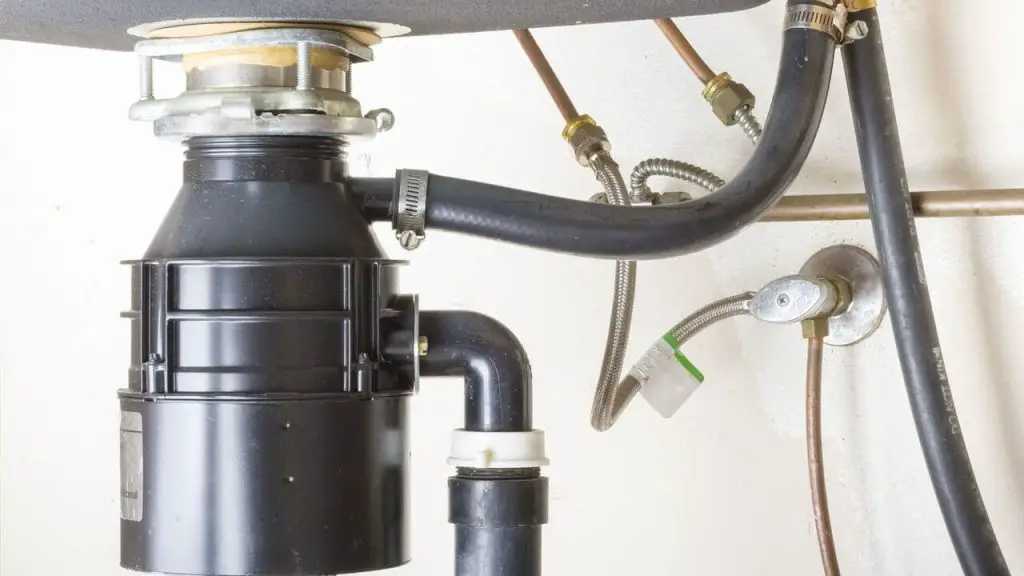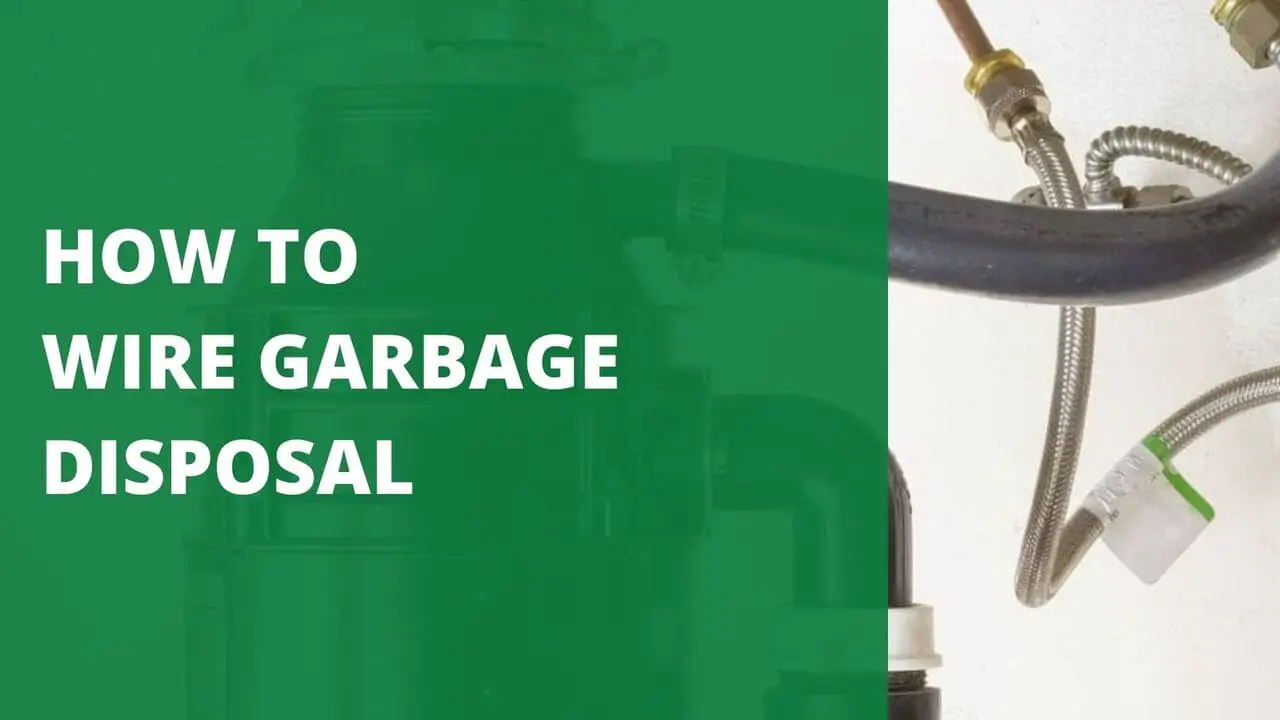As an Amazon Associate I earn from qualifying purchases.
Like most homeowners, you probably take your garbage disposal for granted. You flip a switch, and out goes the trash. But what if one day your disposal stops working? Don’t worry – it’s not as difficult to fix as you might think.
This blog post will show you how to wire garbage disposal. We’ll also provide tips on keeping your disposal running smoothly. So read on to learn how to keep your kitchen clean and tidy!
How to Wire Garbage Disposal: 7 Simple Steps

1. Remove the Wiring Compartment Cover
To remove the metal cover from the wiring compartment on the bottom of your garbage disposal unit, first, locate and remove the screw with a screwdriver. Often, the cover is only secured by one screw. With the pieces removed (you’ll need them later), set them aside.
2. Install Clamp
Install the cord clamp into the hole near the wiring compartment. Insert the threaded end of the clamp into the hole and tighten it with the clamp’s nut on the inside of the base plate. You’ll have to reach through the wiring compartment to thread and tighten the nut onto the clamp. It may be necessary to tap on the lugs of the mounting and untwist a flat head screwdriver to ensure that it is tight.
3. Cut the Required Wires
Prepare the appliance cord wires for connection using a wire stripper by removing about 3/4 inch of insulation from the end of each of the three insulated wires. If you’re using stranded copper, be sure to use notches that are marked “stranded.” Use these notches if you’re working with solid copper. (Stranded copper is larger than solid copper of the same nominal size, necessitating distinct notches on the wire stripper.)
4. Installing the Cable
After you have stripped the wires, feed the end of the cord through the clamp and into the wiring compartment. To secure it, tighten the two screws on top of the clamp. It is important not to overtighten; doing so might damage or deform the cord.
5. Connect the Wires
Use a screwdriver to tighten the ground screw after wrapping the bare-copper end of the green (ground) wire from a cord around it clockwise. To secure white(neutral) cord wire, connect it with white (neutral) wire on a disposal using a connector. Lastly, use a connector again, but this time is connecting black(hot) cord wire with black(hot)wire on disposal. Make sure each title is snug by gently tugging and checking.
6. Replace the Wiring Compartment Cover
Remove the cover and clean out any debris. Slide the wires into the wiring compartment. Replace the compartment cover and tighten it with a screw. After all of the disposal’s plumbing connections have been made, connect it to a switch-controlled, GFCI-protected outlet using the disposal cord. While running water in the sink, try flipping the wall switch to test its operation.
7. Voltage and Current Requirements
If you’re replacing a garbage disposal, you must use the same electrical power and switch as the previous one. Most garbage disposals plug into a 120-volt GFCI outlet located under the sink. If there isn’t already an outlet like this beneath your sink, then you’ll have to ask an electrician to install one for you.
Most disposals need a switch next to the sink to operate the outlet–make sure your electrician wires for this ahead of time. Note: Batch-feed disposals don’t necessitate a switch since they begin when you insert and turn a special drain plug. Instead of buying a conventional electrical switch, an alternative worth considering is an “air switch” for around $50.
Tips to Wire a Garbage Disposal
- The cord clamp may need to be screwed into the disposal unit based on your chosen model.
- You can skip this step if your cord has been stripped of wires. It is desirable to leave the ground wire intact if it also has a ring connector to connect it to the ground wire.
- On some disposals, there is a red hot wire lead rather than a black hot wire lead. If this happens, connect the red wire lead to the black wire on the appliance cord. As some cords are not colored, in these cases, the wire with ridges on its outer edge is the neutral or white wire, the wire in the middle is the ground wire, and the wire without any ridges is the hot wire because in these cases the neutral or white wire has ridges on its outer edge.
Right Time to Hire a Pro
Connecting a plug-in appliance cord to a garbage disposal is simple for anyone with basic DIY skills. The electrical circuit that powers the garbage disposal is another story.
If you don’t already have a switch-controlled wall receptacle (outlet), adding this wiring would be better left to an expert electrician because it entails running cable and making connections at the main service panel. The law generally mandates that a dedicated circuit power only the garbage disposal.
Want to Buy Garbage Disposal Wires?
The InSinkErator 3-Piece Power Cord Kit is simple to install and includes a 3-foot strain relief clamp, wire connectors, and installation instructions. Disposer outlets are connected to a regular wall outlet after installation.
This Insinkerator appliance is suitable for Underwriter Laboratories SPT-3 insulation thickness and moisture resistance. Wire nuts, as well as electrical connections to the motor, are included in the kit. With the iconic appliances, InSinkErator helps you get your kitchen clean quickly and easily.
- POWER CORD KIT: This Power Cord Kit is easy to install & includes a 3-foot, strain relief clamp, wire connectors & installation instructions. Once installed, disposer plugs into a standard wall outlet.
- SAFETY ASSURED: This InSinkErator product meets Underwriter Laboratories SPT-3 category for insulation thickness and moisture resistance. Kit includes 2 wire nuts and electrical connection to motor.
- AMERICA’S #1 DISPOSER BRAND: There are more American-built InSinkErator garbage disposals in US homes than all other brands combined. A full line of models means there’s one right for every need and budget.
Final Words
Now that you know how to wire garbage disposal, it’s time to install it! Be sure to follow the instructions in your owner’s manual carefully. If you’re not comfortable working with electricity, hire a professional to do the job for you. With a little patience and effort, you can have new garbage disposal up and running in no time.
FAQs
How should garbage disposal be wired?
Twist the green (ground) wire around the ground screw on the disposal in a clockwise direction. Securely tighten the ground screw with a screwdriver. Attach the white (neutral) cord wire to the corresponding white (neutral)wire on the disposal using a wire connector.
Are garbage disposals hardwired or plugged in?
Garbage disposals need to either have a direct wire or be plugged into an outlet that the electrical company has approved. It is suggested that there should be a circuit only for the disposal, but if needed, it can share a circuit with the dishwasher.
What size breaker do I need for disposal?
If upgrading your garbage disposal, you’ll need to know what size breaker to use. The garbage disposal consumes approximately 15 amps, so a 20-amp breaker is usually sufficient. Some models, on the other hand, may require a 30-amp breaker. Always double-check the manufacturer’s recommendations to be sure.
Can garbage disposal and dishwasher be on the same circuit?
For example, a 20-amp circuit breaker is required for connecting a garbage disposal and a dishwasher to the same circuit. You’ll also need to ensure that the combined amperage of the two appliances does not exceed 80% of the circuit’s amperage capacity.
Additional Contents
- How Much Does it Cost to Install Garbage Disposal
- How to Get Glass Out of Garbage Disposal
- How to Make Garbage Disposal Smell Better
- How to Get Rid of Garbage Disposal Smell
- How to Reset A Garbage Disposal
Amazon and the Amazon logo are trademarks of Amazon.com, Inc, or its affiliates.



